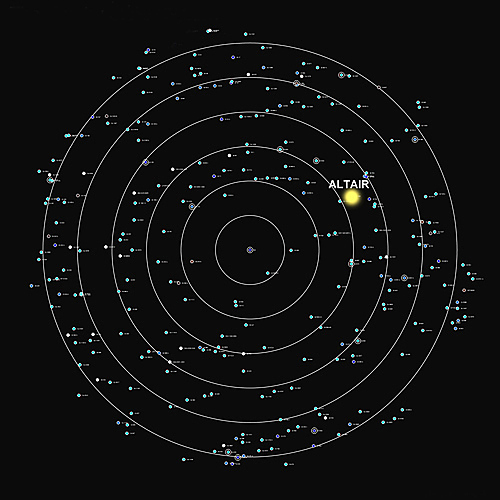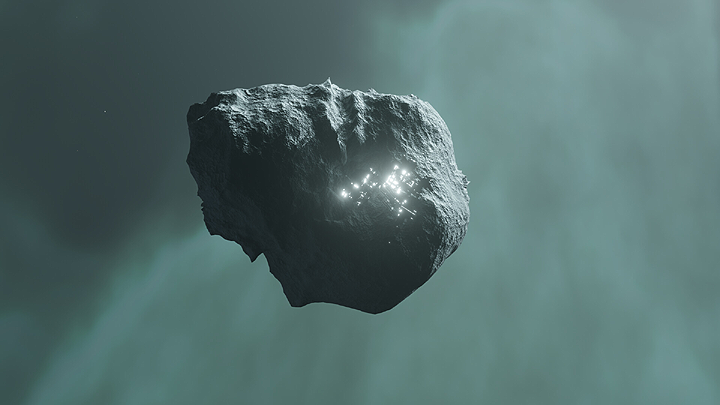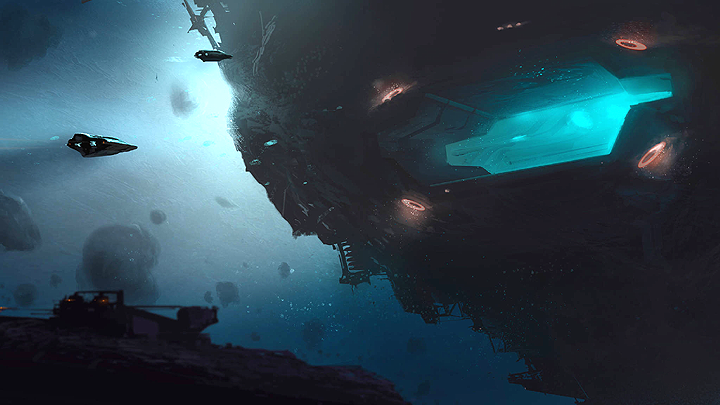
DISTANCE: 16.7 light years from Sol
NEIGHBORING SYSTEMS: 61 Cygni 9.7 lys Gliese 876 13.8 lys 70 Ophiuchi 16.5 lys
ALTAIR is a white dwarf which has over ten times the visual luminosity of Sol. It has over twice the amount of heavy elements and radiates much more in ultraviolet wavelengths. Being a relatively youthful star, this system is still in the process of planetary formation. The inner regions contain a thick cloud of dust and debris as well as a countless number of rocky planetoids; many of which are larger than Earth’s moon. Beyond this orbits a solitary gas giant which is nearly half the size of Jupiter. At the distant edge of the system is an incredibly dense asteroid field and the entire system contains substantial amounts of Divinium ore.
AKIRA is a large gas giant made up primarily of hydrogen, helium, and methane with substantial amounts of ammonia as well. The planet has an intense internal heat source and radiates an enormous amount of energy on its own. Akira also has a total of 53 small moons; many of which are mined for their valuable resources.

The Tansaku-teki division of Hoshi Enterprises surveyed the Altair system in 2175 and found it to contain a variety of valuable metals as well as an endless supply of stellar energy. Establishing a mining operation in this system became an immediate priority for the company. However, due to the lethal levels of ultraviolet radiation, any permanent Human colony would have to be located at quite some distance from the host star to avoid any long-term exposure.
Hoshi Enterprises re-located over 3000 of its best engineers to the Tetsuo Cluster situated at the distant edge of the system. This collection of large asteroids is believed to have, at one time, been a proto-planet which broke apart, yet maintained its original orbit outside of the main radiation zone. This highly-skilled workforce began a massive undertaking; excavating over five square kilometers of rock from the interior of Kaneda, the largest of these asteroids. Within six months, they installed newly improved gravity generators and EM shielding into what would soon become subterranean living areas deep below the surface.
Upon completion, thousands of individuals, many of whom had worked together at the Hygeia mining outpost in the Sol system, established this as the tenth system outside of Sol to be permanently colonized by Humans. As the first group of colonists settled into their new environment, crews began excavating other nearby asteroids which would eventually become new outposts. Each outpost was designed in a similar fashion with large hanger bays at the entrance to accommodate a wide-range of spacecraft, small residential units built into the perimeter of the cavern walls, and an enormous communal area at the center for open markets and social functions.

Much like the Cygnians, the “Altairans” have a great reverence for life. Acceptance and openness towards others is at the core of their beliefs and all individuals are given the opportunity to contribute to their society. Yet, for many of them, colonizing a system where high levels of UV radiation actually inhibit the development of life has sometimes been a daunting experience. However, advancements in botanical sciences have allowed them to cultivate huge expanses of subterranean farmland and produce a large assortment of flourishing plant-life as well. According to the official census of the Tetsuo Cluster in 2233, the combined Human population, spread out across eight separate asteroids, has reached a total of 1.5 million people.
For 20 years, these outposts remained the most distant of all the Human colonies. Their collective community continued to grow and thrive by mining the irradiated moons of Akira where they could extract the purest Divinium ore. The Altairans traded this new energy resource with their sister colonies in the 61 Cygni and Gliese 876 star systems in exchange for a variety of goods and provisions and sold it on the open market to Earth and many of the other Human settlements as well. However, due to their rapid success, they were often subjected to corporate espionage and even piracy by freelance contractors working covertly for the Lao Che Syndicate.
During a routine survey in the outer perimeter of the system, an Altairan mining vessel, the HEC-268 KYUSHU, encountered an advanced spacecraft of unknown origins. As they investigated the unidentified vessel, it began emitting an invasive signal that implanted new data directly into the Altairans’ main computer. The crew of the KYUSHU took this as an act of aggression and raised their shields in an effort to defend themselves. Yet, just as suddenly, the signal ceased and a new audio message was transmitted in an unknown language. This message was automatically translated by a new program which had been embedded in their communications system.
“We give honor to you, those from Earth. We regret any misgivings that may have resulted due to our actions. It was necessary to provide you with our translation matrix in order to communicate with you more easily. We are known as the Brekka. Our species originates from a planet in orbit around a star which you refer to as HR 7722. We have come to offer ourselves as guides on your journey into a much larger interstellar community.”
This was the moment that would go down in Human history as their first official contact with another sentient species. The Brekka had been quietly observing them for over two hundred years and felt it was finally time to reveal themselves because the Human race was on the verge of entering regions of space inhabited by other intelligent lifeforms. Emissaries from the Kaneda outpost were invited to come aboard the alien vessel where they met face to face with the Brekka for the first time. As they got to know each other, a genuine bond developed between them based primarily on their shared belief in the sanctity of all life. Although the Brekka were unwilling to share the full extent of their technology, they did propose a cooperative project to construct a new orbiting space station where the two races could come together in harmony.
In 2180, the construction of UNITY STATION was completed and representatives from each of the Human-occupied systems were all invited to attend an historic inaugural ceremony. Due to the propulsion engines that Humans used at the time, it took some of them over a month to travel to this distant system. Yet, once they arrived, it didn’t take long for it to become obvious how much conflict there was between Earth and many of its colonies. In addition, some of them regarded the Brekka with suspicion and resentment for not sharing more of their technology. During the opening convention with all of the delegates assembled together, a covert terrorist faction detonated an explosive device inside the station which killed over 800 individuals; including the Brekka ambassadors. The Brekka themselves were completely unprepared for this level of hostility. Much to the regret of those who had a sincere desire for peace, the Brekka chose to withdraw and distance themselves until Humans could work out their own differences.

During the Zendathu-Human War, this system was designated as the location of Hoshi Enterprises’ primary ship-building facility. These ships, constructed to incorporate multi-layered shielding and galvanic pulse weapons, were also among the largest ships in the colonial fleet. Although very few Altairans actually took part in any of the battles, they contributed to the war through their manufacturing efforts and distribution of resources.
Following the war, Earth’s corporate empire levied higher taxes on most of it’s colonies and tightened it’s hold on any noncompliant systems. When the UEC attempted a military takeover of Hinode, all three of the colonies established by Hoshi Enterprises were outraged by this deliberate incursion. Representatives from 61 Cygni, Gliese 876, and the Altair system convened at the Kaneda outpost to sign a pact which, not only declared their official separation from Earth, but also included a pledge to defend each other in times of crisis. This Free Worlds League was not intended to function as a conjoined government for these colonies, but as a mutual alliance of independent systems.
The Kaneda outpost continues to be the central hub for trade and commerce within this system. It has also become a waystation for crews to refuel their vessels and replenish supplies before heading into the unknown Eastern regions of space. To this day, the Altairans are well-known for their warmth and kindness, not only towards each other, but to all who visit their distant cluster of outposts. Trustworthy, friendly, and eager to please; they are typically most comfortable when surrounded by the company of others and are renowned for their generous hospitality.